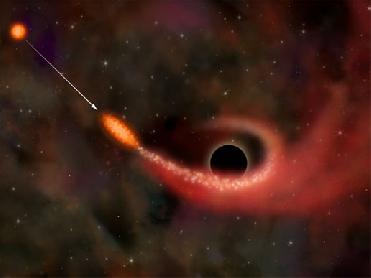
An artists's conception of a supermassive black hole. Image credit: NASA
PARIS (BNS): In a study that could shed light on the connection between black holes at the centre of galaxy clusters and the surrounding gas that serves them as ‘food’, scientists at the University of Bonn have established what they term the “cosmic feeding” theory.
In their study that has appeared in the scientific journal Astronomy and Astrophysics, the researchers have drawn conclusion about the “food situation” of the black holes by observing the radiation in their vicinity.
The radiation derives from the material that is being slowly absorbed by the black hole. This “food” is mainly ingested by the insatiable cosmic bodies in the form of hydrogen gas.
For black holes, gas is only “edible” if it is cooled down sufficiently. “The particles in hot gas move too quickly for them to come close enough to be pulled into a black hole,” said Dr. Thomas H. Reiprich at the Argelander Institute for Astronomy in Bonn.
Explaining further, Dr. Rupal Mittal, the study's principal author, said, “For that to happen, the gaseous mixture must cool down. Just how long the cooling process lasts can vary. A billion years is very a short period by cosmic standards.”
The black hole at the centre of a galaxy cluster in which the gas cools “quickly” enough will receive “edible” gas in abundance and be correspondingly active. The centres of galaxy clusters in which these processes take considerably longer are, in turn, far less lively, the University said in a press release.
The idea that all central black holes in galaxy clusters are active if there is sufficient gas available was already postulated by scientists. But the current work by the Bonn research group furnishes the evidence.
“Earlier research had identified a high proportion of such galaxy clusters, but we have now been able to demonstrate that it's not just a 70 per cent incidence but applies to all cases,” Reiprich said. “All galaxy clusters that cool down rapidly, and thus have an abundance of gas available in their interior, reinvigorate supermassive black holes – like a fresh log on a dying wood-fire. In other words, the black holes will really get going if their wide environment is right,” he added.
As part of their study, the astronomers combined the measurement of radio waves with X-ray images of more than 60 galaxy clusters and examined the phenomena more closely.
Using the observations, they determined which galaxy clusters contain, in their cores, gas that can serve as food for black holes. And, by means of radio data, the scientists analysed the activity of supermassive black holes, the statement said.
 Next Article
Next Article













The Indian Air Force, in its flight trials evaluation report submitted before the Defence Ministry l..
view articleAn insight into the Medium Multi-Role Combat Aircraft competition...
view articleSky enthusiasts can now spot the International Space Station (ISS) commanded by Indian-American astr..
view article